
Community Wildfire Mitigation Best Practices Toolbox
Mitigation Guiding Principles
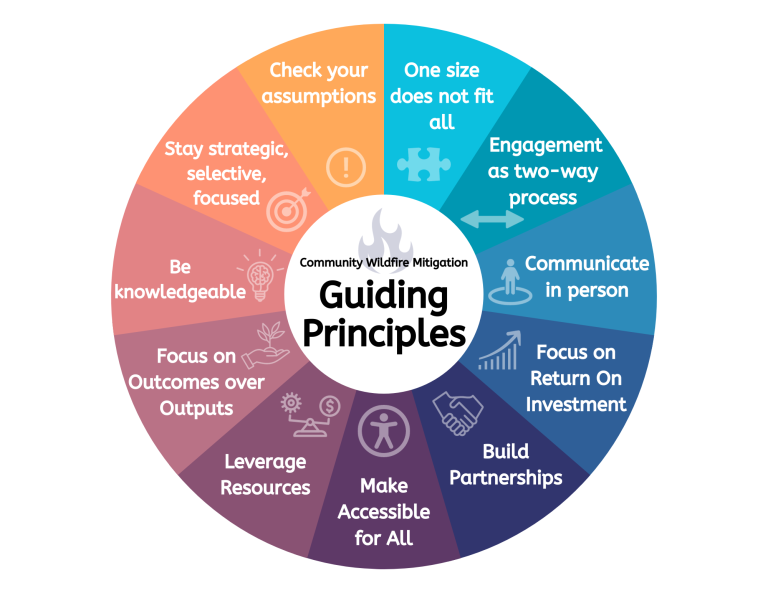
Community Wildfire Mitigation Guiding Principles are the foundation for effective work with communities; they are the key to increasing local capacity. The guiding principles below will resonate throughout this page and are the foundation upon which an effective action-focused mitigation program can be built.
- Engagement: Trust-based relationships and face-to-face engagement are the basis for success
- Communicate in person when possible- messaging (emails, advertisements, newspaper campaigns) and engagement are not the same; messaging should not be used in lieu of face-to-face communication
- Target high to medium risk areas and communities
- Build partnerships to work collaboratively across boundaries and jurisdictions
- Make mitigation support accessible to all at-risk populations
- Focus on outcomes over outputs
- Leverage resources
- Be an expert: know your communities risk and focus work to reduce the risk
- Stay strategic, selective and focused
- Be flexible and adapt
- Check your assumptions
Safety

Safety should be the top priority on every mitigation project. The safely of personnel and the public is of chief importance. While conducting mitigation work, every attempt should be made to prevent accidents from occurring.
A robust safety program should include the following components:
- An organizational safety policy
- A site specific job hazard analysis (JHA)
- Incident reporting tool(s)
- Liability release forms
Policy

In our collective pursuit of effective Community Wildfire Mitigation activities, it is imperative that our strategies are firmly rooted in the realities of our environment and driven by tangible outcomes. The journey towards safeguarding our communities demands a profound understanding of the comprehensive network of resources available to us, both from governmental and non-governmental entities.
Across various tiers of governance, a mosaic of policies, strategies, and roadmaps has been meticulously crafted to provide us with the tools we need to accomplish our mission. While certain policies might present challenges (such as Home Owner Association regulations limiting tree removal), numerous national policies stand as beacons of guidance, offering strategies to channel our mitigation endeavors effectively.
The resources presented here span a spectrum of guidance documents, policies, and high-level recommendations, curated to assist you in crafting a resilient and effective wildfire mitigation strategy tailored to your community’s unique context.
FEMA
Wildland Urban Interface: A Look at Issues and Resolutions
USDA Forest Service
Confronting the Wildfire Crisis
The Nature Conservancy & Energy Environment
Roadmap for Wildfire Resilience: Solution for a Paradigm Shift
National Fire Protection Association
Policy Recommendation to Reduce Home and Community Loss from Wildfire: Report on Outthink Wildfire Summit
International Fire Chiefs Association
Collaborative Efforts for Reducing Community Risk in the Wildland Urban Interface
Guidelines for Managing Private Resources on Wildland Fire Incidents
Headwaters Economics
Federal Wildfire Policy and the Legacy of Suppression
Mitigation Leadership

The most essential element of wildfire mitigation is competent and confident leadership. Leadership means providing purpose, direction, and motivation for residents, stakeholders, and partners to take action to reduce risk.
The Mitigation Leader must:
- Prioritize activities that are effective and efficient and lead to mitigation risk reduction action.
- Use resources wisely.
- Motivate action of residents, staff, and partners.
- Facilitate change and action through mitigation strategies.
- Communicate clearly and concisely using common sense and understandable language.
- Resolve conflict through active listening and understanding.
Capacity

Capacity is the all-important “infrastructure” that supports and shapes organizations into sustainable, efficient, and effective change agents. Capacity building enables organizations and their leaders to develop competencies and skills in the delivery of a service.
Increasing Organizational Capacity
- Stop undertaking activities that provide a minimum return on investment.
- Focus on risk reduction actions.
- Ask for help. Ask partners, volunteers, and residents to help with activities they can support.
- Home Assessments
- Project coordination
- Mitigation event coordination
- Volunteer time tracking
- Trust your partners.
- Review programs frequently.
- Be nimble – adjust inefficient programs, services or projects when outcomes are less than desired.
- Adapt – Allow flexibility in program design to allow for rapid changes.
Increasing Community Capacity
- Encourage residents to actively participate. Providing free, no-labor mitigation services do little to grow mitigation capacity. Provide opportunities for participation in all phases of the work.
- Explain that one parcel treated will do little to change fire effects, behaviors, and outcomes.
- Focus on the positives
- We can change the trajectory.
- Our actions, even seemingly small ones can create positive outcomes
- Set a positive example. You can help adjust attitudes and perceptions by working on your property.
- Listen closely to the needs and concerns residents have
Increasing Organizational Capacity:
Community Asset Mapping
ABCD Institute Took Kit
Community Connections with Asset Mapping
Increasing Community Capacity:
Neighborhood Ambassador Approach
Neighborhood Ambassador Approach
Tools and Resources
Photopoint Monitoring
Volunteer Project Info Sheet Template
Example volunteer info sheet with helpful notes
Sign-In Sheet Template
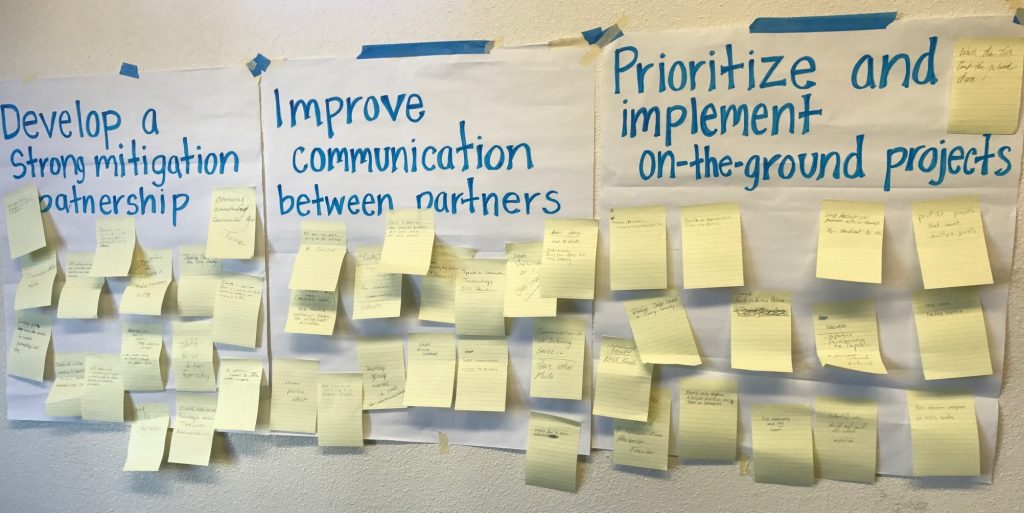
Building & Maintaining Partnerships

Partnerships increase capacity. The problem of wildfire risk is far too large for any one person or organization to manage alone. Within this section, we share a few partnership tools and resources. The Huerfano County Assignment Report has a nice section on developing a partnership and the Community toolbox includes extensive resources from the development to maintenance phases of a partnership.

Assessing Your Partnership
Digging Deeper – Finding Answers
Partnership Impact Evaluation Guide
The Wilder Collaboration Factors Inventory
Creating Coalitions and Partnerships
BLM: Engaging With Communities in Public Land Stewardship
Community Engagement Guidelines
Community Toolbox
Developing Landscape-Scale Partnerships
Field Guide to Developing Partnerships
Partnership Success Factors
Community Mitigation Assistance Team
Huerfano County Assignment Report
Landscape Fuels Treatments

Landscape fuel treatments include thinning, prescribed burning, pruning, and mechanical treatments such as mastication or mowing. Mitigation Specialists carefully select treatments to help reduce and rearrange the amount and continuity of fuel within a forest stand and across the landscape. Treatments in the wildland-urban interface (WUI) should cross jurisdictional boundaries to reduce overall wildfire risk and strengthen local partnerships.
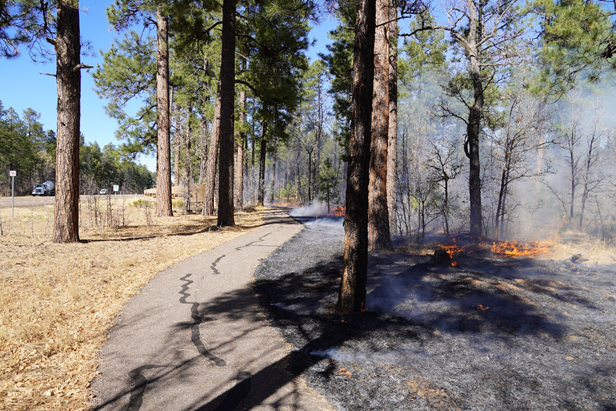
Wildland Urban Interface
Wildfire, Wildlands, and People
Cross-Boundary Case Studies
Klamath and Lake Counties of Oregon
Evaluating Effectiveness
Evaluating the Effectiveness of Wildfire Mitigation Activities in the Wildland-Urban Interface, Forest Stewards Guild
Forestry Tools and Techniques
Mastication
To Masticate or Not
Wildfire Risk Reduction Projects
Planning and Implementing Cross-Boundary Projects
Forestry BMP to Protect Water Quality in Colorado
Fuelbreak Guidelines for Forested Subdivisions
Gambel Oak Management
Lodgepole Pine Management Guidelines
Mistletoe Management
Ponderosa Pine Forest Desired Conditions
Restoring Composition and Structure in Southwest Forests
Small-Area Forestry Equipment
Shared Stewardship Across Landscapes
Wallow Fire Fuel Treatment Effectiveness
Structure Hardening, Defensible Space, & HIZ

Structure hardening means modifying a structure to make it more resistant to ignition from direct flame contact or radiant and convective heat, as well as from burning embers that may fall on or near the home. Hardening creates a home that is less vulnerable to ignition without fire department intervention. This is important because in a wildland-urban interface (WUI) fire there are never enough fire engines to protect every home.
Defensible space describes an area about 100 feet from the structure where combustibles have been removed or altered to reduce wildfire risk. The distance may be increased to 150-200 feet if the structure is in steep terrain.
Similar and often used interchangeably to the term defensible space, the Home Ignition Zone (HIZ) refers to the “the area where the factors that principally determine home ignition potential during extreme wildfire behavior (high fire intensities and burning embers) are present. The characteristics of a home and its immediate surroundings within 100 feet comprise the HIZ.
Insurance Institute for Business and Home Safety (IBHS)
Creating a Fire-Adapted Home
Risk Research and Insights
National Fire Protection Association (NFPA)
Research Fact Sheet Series
Understanding the Wildfire Threat to Homes
Annotated Structure Hardening
Preparing for Wildfire
Retardant Treated Wood
Fire Ratings for Construction Materials
Fire Ratings for Roofing Material
Impact of Oil-Based Penetrating Stains
Window Failure During Wildfires
Vulnerabilities of Buildings
Homeowners Retrofit Guide
Defensible Space and the Home Ignition Zone (HIZ)
The Wildland-Urban Interface Fire Problem
A Publication for the Inland West
Barnyards and Beyond
How to Prepare Your Home for Wildfire
Protecting and Landscaping Homes
Preventing Disaster
Create Defensible Space
Creating Wildfire Defensible Zone
Protecting Your Home from Wildfire
HIZ Structure Assessment Guide
Reducing the Wildfire Threat to Homes
Pathways for Building Fire Spread
Structures Lost to Wildfire
Waldo Canyon Final Report
Wildfire Home Assessment and Checklist
Low-Cost Retrofit List
Homeowner’s Wildfire Mitigation Guide
Community Wildfire Protection Plans

A Community Wildfire Protection Plan (CWPP) identifies and prioritizes areas for hazardous fuel reduction treatments and recommends the types and methods of treatment on federal and non-federal land that will protect one or more at-risk communities and essential infrastructure and recommends measures to reduce structural ignitability throughout the at-risk community.
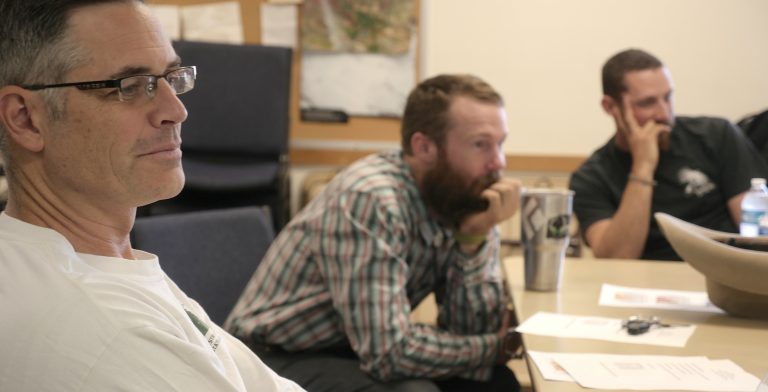
Review Guides and Documents
Preparing a Community Wildfire Protection Plan
Guide to Preparation and Implementation
Evaluation Guide
Leader’s Guide
Best Management Practices
Integrating Community Wildfire Protection Plans and Natural Hazards Mitigation Plans
Examples of High-Quality CWPPs
Deschutes County, Oregon (Project Wildfire)
Curry County, Oregon
Landowner Outreach
CWPP Magazine
Community Assessment Resources
Community Assessment Template
FireWise Community Assessment
Home Site Visits & Risk Assessments

Home site visits are a one-on-one interactive opportunity between a community mitigation specialist and a property owner. They are critical to engaging property owners or residents in risk-reduction activities on private property. Home site visits are often the first active step in moving property owners to take mitigation action.
One-on-one comprehensive site visits with property owners are a best practice.
They are important because they:
- Identify specific vulnerabilities.
- Guide residents’ risk reduction actions.
- Help create relationships built on trust.
- Highlight homeowner hesitancy and concerns.
- Provide an opportunity to address barriers to action.
Mitigation Funding

Community-wide fuels projects involve planning and funding. This section lists several national resources to help in these efforts.
Funding mitigation work is often cited as the biggest barrier to action; however, some work can occur without funding. Property owners must take responsibility for mitigation actions on their own land and when they can, contribute in-kind or financially to the mitigation projects.
- Remove bark mulch, needles, and other flammable materials from within 5 feet of the home.
- Regularly clear vegetation from the property. For example, keep grass and weeds cut within 100 feet of the home.
- Remove needles and leaves from gutters, roofs, and decks.
- Move firewood to at least 30 feet away from the home on the uphill side.
National Funding Authorities and Programs
Rural Voices for Conservation Coalition (RVCC) Primer: From Ideas to Action
Federal Emergency Management (FEMA) Pre-Disaster Mitigation Grant
Bureau of Land Management (BLM) Community Assistance
Natural Resource Conservation Service (NRCS) Environmental Quality Incentives Program
Federal Excess Property Program
Secure Rural Schools Act
National Forest Foundation
American Forest Foundation
The Nature Conservancy
COCO’s Action, Implementation and Mitigation Grant
International Association of Fire Chiefs (IAFC) Ready, Set, Go! Grants
Cost-Share
Service Agreement
Additional Guidance
Funding Alternatives For Emergency Medical and Fire Services
Mitigation Events

Mitigation events include chipper days, slash hauling, community cutting/thinning projects, general landscape clean-up days, creation of defensible space around a public structure or in a park, and many other activities. Mitigation events are a great way to motivate people to get involved and take action. They create results on-the-ground but also provide opportunities for “first contact” between mitigation specialists and residents who are not already engaged.
Mitigation events need to happen all year long. Far too often we hear about a month or a day where everyone gets together to reduce risk. One day is a great start but it is not enough! Being prepared for a wildfire must be woven into the culture of your community. Much like mowing a yard or pulling weeds from the garden, wildfire mitigation activities and events should occur frequently.
Tracking Progress & Celebrating Successes

Wildfire mitigation activities occur over time and fall within the Mitigation Continuum. It is important to understand and track successes, gaps, barriers, and challenges. When tracking progress consider how mitigation activities are meeting your goals.
Track:
- Contact information
- Risk inventory
- Mitigation outcomes
- Investments
It’s important to recognize and celebrate success. Mitigation isn’t easy! Acknowledging hard work and the results boosts morale. Consider nominating your local wildfire mitigation leaders, landowners, and volunteers for a mitigation award. There are national-level awards and most municipalities have a Volunteer of the Year recognition. That said, always remember that the goal of defensible-space programs is wildfire risk reduction, not recognition.
Volunteer Templates
Sign-In Sheet Template
Volunteer Project Info Sheet Template
Example volunteer info sheet with helpful notes
Volunteer Standard Operating Procedure Example/Template
Landowner Forms
Landowner In-Kind Tracking Form
Volunteer Release Forms
CUSP Volunteer Release
National Awards and Nominations
Wildfire Mitigation Awards
Codes & Ordinances

Codes and ordinances can play an important role in community risk reduction in communities that embrace and enforce them. A few items we want you to consider.
The most effective codes and ordinances are specifically designed and embraced by the local community to meet specific needs.
- Without buy-in from residents or understanding of intent, code requirements are often viewed as additional cost/burdens.
- WUI codes and ordinances are not for everyone. Many communities will not tolerate regulations or do not have the capacity to adopt, implement, and enforce them.
Codes and ordinances are not a silver bullet, but can be a valuable part of your mitigation program.
Codes and ordinances require a significant investment in time to develop, maintain and enforce.
Firetopia Land Use Toolbox
Firetopia is a great tool that dives into land use planning through an interactive dashboard.
Community Planning Assistance for Wildfire (CPAW)
Planning the Wildland-Urban Interface
NFPA 1141
Protection for Land Development
Reducing Structure Ignition Hazards
International Code Council (ICC)
International Wildland-Urban Interface Code
Locally Adopted Codes
Colorado Springs, Colorado
Colorado Springs Manual
Ashland, Oregon
Ashland Informational Brochure
Flagstaff, Arizona
Rapid City, South Dakota
Community Engagement

Connecting with people is essential for effective community risk reduction actions. There are many ways to communicate and connect; some are active, others are passive. The key is knowing when to use each communication approach.
- Active communication is face-to-face engagement and two-way communication based on questions and answers. Both parties are highly involved, and both come away with a better understanding of the issues discussed. Active communication leads to action.
- Passive communication is second-hand communication – like brochures, news releases, articles, or websites. Passive communication doesn’t usually produce action, but it can help point people to resources (such as meeting details, how to apply for funding, or whom to contact for help).
To understand individual barriers to mitigation and to move people toward action, relationships must be built on trust. Building trust requires active communication.
Wildfire risk reduction requires a change in behavior. Some people will change behavior more easily than others. These so-called “early adopters” can influence followers, leading, eventually, to a tipping point of action.
Engagement and Why People do not Mitigate
- Face-to-face engagement is the critical component that leads to action on-the-ground. Personal connections allow us to talk about the value of mitigation, explain why homes burn, and detail how property owners can help themselves. Face-to-face encounters are an opportunity to share personal values about homes, risks, and responsibilities.
- It’s important to understand WHY property owners may be resistant to mitigation or see no need to reduce risk. Understanding motivations can help a mitigation specialist address concerns and propose compatible solutions. It also helps a mitigation specialist match or build more effective resources for helping residents who want to take action.
Messaging, Social Media, and Community Meetings
- When properly planned, messaging and meetings can be effective tools for raising awareness and sharing information. They can also help establish first contact. But messaging and meetings alone will not result in mitigation.
- Messaging, social media, and community meetings are awareness tools to educate target audiences about wildfire risk and what can be done to mitigate that risk. None are substitutes for face-to-face engagement to motivate people to take action.
- Messaging is second-hand or passive communication for information sharing. Literature, news releases, articles, announcements, leaflets, and social media are passive tools to educate the target audience about wildfire risk, available technical assistance, meeting times and dates, and other information regarding wildfire mitigation.
Engaging Homeowners
Landowner Engagement Guide
What motivates homeowners to mitigate wildfire risk?
Overcoming Common Barriers to Action
Nudging: A Very Short Guide
Communication
Best Practices in Risk and Crisis Communication
Social Science Findings for Managers
Trust: A Planning Guide for Wildfire Agencies and Practitioners

Social Science

While the ultimate goal of a mitigation specialist is to increase mitigation activities on the ground, it is imperative to understand the communities we work in before making assumptions about attitudes and beliefs about wildfire risk reduction. This section features peer-reviewed papers from wildfire social scientists that take a deeper dive into known tactics that increase mitigation activities.
Featured Researcher Biographies:
Brenkert-Smith, Hannah. Hannah Brenkert-Smith is an Environmental Sociologist at the University of Colorado at Boulder. In the past ten years, Hannah’s work has focused primarily on household and community response to wildfire risk. In particular, this work has focused on risk mitigation decision-making and forest and wildfire hazard planning related to informal social interactions and a sense of place. Some of her research is listed here.
Champ, Patty. Patty Champ is an Economist in the Human Dimensions Program at the USDA Forest Service’s Rocky Mountain Research Station in Fort Collins, CO. Patty’s research focuses on three aspects of wildfire: wildland-urban interface homeowners’ risk mitigating behaviors, the economic costs of exposure to wildfire smoke, and the effects of wildfire risk on home sales prices. Some of her research is listed here.
Cohen, Jack. Jack D. Cohen is a retired Research Physical Fire Scientist who worked with the USDA Forest Service Missoula Fire Sciences Laboratory. Cohen was and still is considered the preeminent researcher on wildfire and home ignitions. Cohen is a founder of the Firewise Communities/USA recognition program, and coined the concept and phrase “home ignition zone.” Some of his research is listed here.
Jakes, Pamela. Pamela J. Jakes is a retired Research Forester who worked with the USDA Forest Service Northern Research Station. She is considered a leading authority on social interaction with wildfire. Some of her research is listed here.
McCaffrey, Sarah. Sarah M. McCaffrey is a Research Forester who works at the USDA Forest Service Northern Research Station. She is considered a leading authority on science to improve our understanding of the social and economic dimensions of fire and fuels management. Some of her research is listed here.
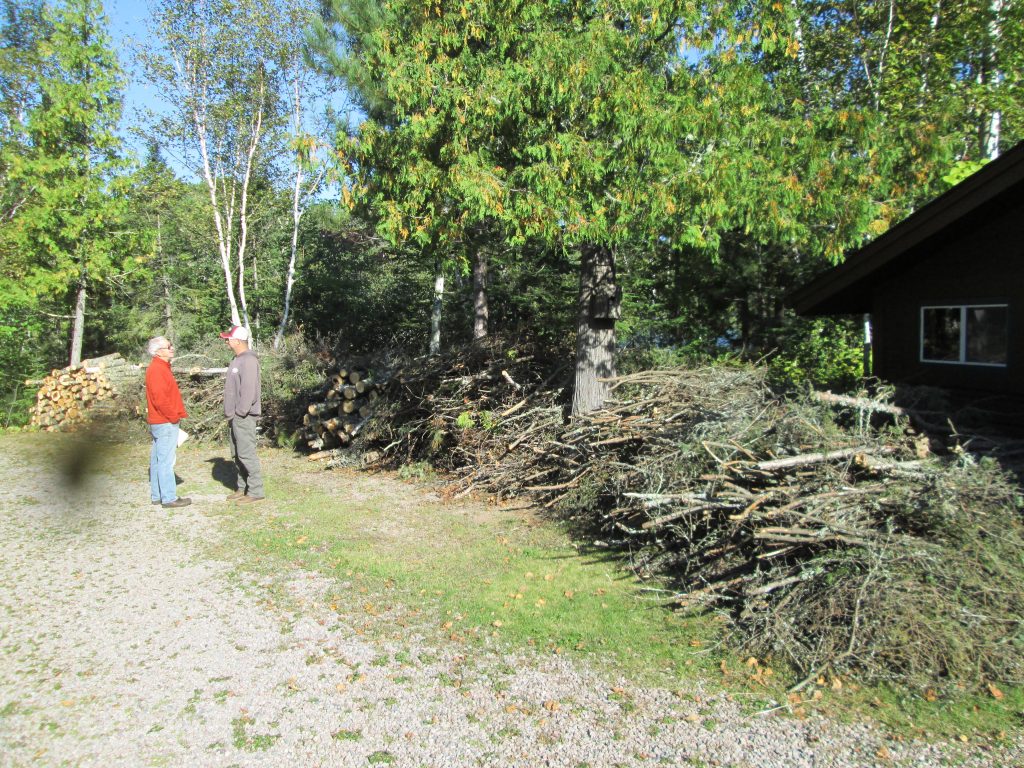
Best Practices in Risk and Crisis Communication: Implications for Natural Hazards Management Natural Hazards. 65(1):683-705.Toman, Eric; Stidham, Melanie; McCaffrey, Sarah; Shindler, Bruce. 2013.
Collaborative Planning to Reduce Risk Martin, Wade E.; Raish, Carol; Kent, Brian: eds. Wildfire risk human perceptions and management implications. Washington, DC: Resources for the Future: 44-63.
Fire on the mountain: What motivates homeowners to reduce their wildfire risk?
Brenkert-Smith, H.; Champ, P.A.: https://www.fs.usda.gov/rmrs/fire-mountain-what-motivates-homeowners-reduce-their-wildfire-risk
Outreach Programs, Peer Pressure, and Common Sense: What Motivates Homeowners to Mitigate Wildfire Risk (2011) In working to foster fire-adapted communities, individuals and organizations need to understand the dynamics of public support for fuel management on private and public land.
Proceedings of the Second Conference on the Human Dimensions of Wildland Fire Gen. Tech. Rep. NRS-P-84. Newtown Square, PA: U.S. Department of Agriculture, Forest Service, Northern Research Station: 88-95.
The Role of Community Policies in Defensible Space Compliance
Forest Policy and Economics. 11: 570-578. Winter, Greg; McCaffrey, Sarah; Vogt, Christine A. 2009.
Social Science to Improve Fuels Management: A Synthesis of Research on Collaboration Sturtevant, Victoria; Moote, Margaret Ann; Jakes, Pamela; Cheng, Antony S. 2005. Gen. Teck. Rep. NC257. St Paul, MN: U.S. Department of Agriculture, Forest Service, North Central Research Station. 84 p.
Social Science at the Wildland Urban Interface: A Compendium of Research Results to Create Fire-Adapted Communities Gen. Tech. Rep. NRS-111. Newtown Square, PA: U.S. Department of Agriculture, Forest Service, Northern Research Station. 75 p.McCaffrey, Sarah M.; Winter, Greg. 2011.
The Wildfire Research Center (WiRē)
WiRē’s researcher-practitioner collaboration supports investigations that address academic and applied concerns jointly. This link lists WiRē’s studies published in the peer-reviewed literature, as well as publications from related collaborations involving our individual group members.
Understanding Homeowner Preparation and Intended Actions When Threatened by A Wildfire McCaffrey, Sarah M.; Fisher, Cherie LeBlanc, eds. 2011.
Understanding the Public Perspective of Wildfire Risk
Martin, Wade E.; Raish, Carol; Kent, Brian, eds. Wildfire risk, human perceptions, management implications. Washington, DC. Resources for the Future: 11-22. McCaffrey, S. 2008.
Understanding Social Complexity Within the Woodland Urban Interface: A New Species of Human Habitation? 2009 Environmental Management. 43: 1085-95.
Working with Community Leadership to Promote Wildfire Preparedness
McCaffrey, S.M., tech. ed. The public and wildland fire management: social science findings for managers. Gen.Tech. Rep. NRS-1. Newtown Square, PA: U.S. Department of Agriculture, Forest Service, Northern Research Station: 137-149.
